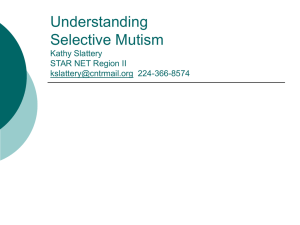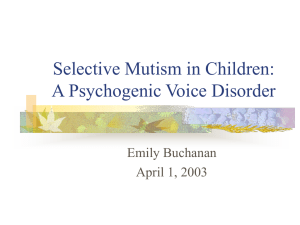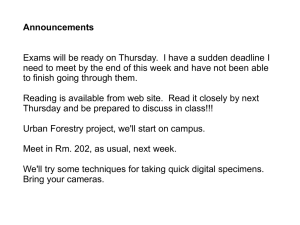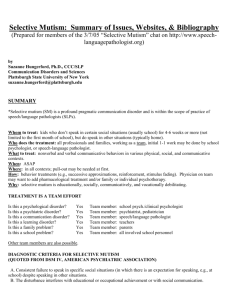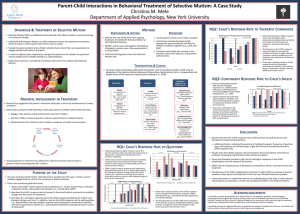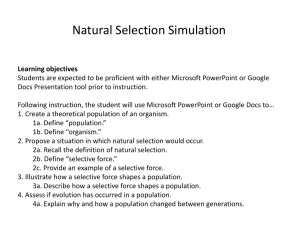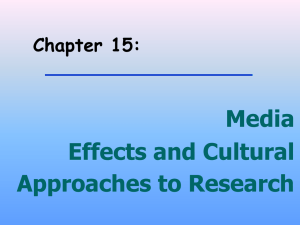A Socio-Communication Intervention Model for Selective Mutism
advertisement
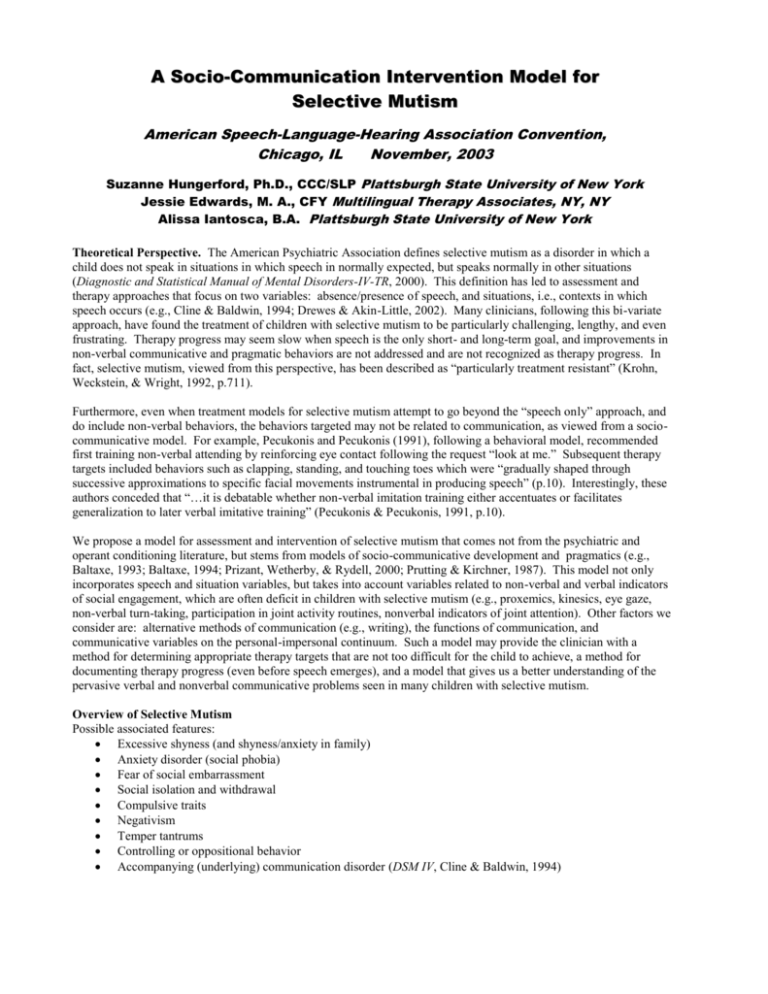
A Socio-Communication Intervention Model for Selective Mutism American Speech-Language-Hearing Association Convention, Chicago, IL November, 2003 Suzanne Hungerford, Ph.D., CCC/SLP Plattsburgh State University of New York Jessie Edwards, M. A., CFY Multilingual Therapy Associates, NY, NY Alissa Iantosca, B.A. Plattsburgh State University of New York Theoretical Perspective. The American Psychiatric Association defines selective mutism as a disorder in which a child does not speak in situations in which speech in normally expected, but speaks normally in other situations (Diagnostic and Statistical Manual of Mental Disorders-IV-TR, 2000). This definition has led to assessment and therapy approaches that focus on two variables: absence/presence of speech, and situations, i.e., contexts in which speech occurs (e.g., Cline & Baldwin, 1994; Drewes & Akin-Little, 2002). Many clinicians, following this bi-variate approach, have found the treatment of children with selective mutism to be particularly challenging, lengthy, and even frustrating. Therapy progress may seem slow when speech is the only short- and long-term goal, and improvements in non-verbal communicative and pragmatic behaviors are not addressed and are not recognized as therapy progress. In fact, selective mutism, viewed from this perspective, has been described as “particularly treatment resistant” (Krohn, Weckstein, & Wright, 1992, p.711). Furthermore, even when treatment models for selective mutism attempt to go beyond the “speech only” approach, and do include non-verbal behaviors, the behaviors targeted may not be related to communication, as viewed from a sociocommunicative model. For example, Pecukonis and Pecukonis (1991), following a behavioral model, recommended first training non-verbal attending by reinforcing eye contact following the request “look at me.” Subsequent therapy targets included behaviors such as clapping, standing, and touching toes which were “gradually shaped through successive approximations to specific facial movements instrumental in producing speech” (p.10). Interestingly, these authors conceded that “…it is debatable whether non-verbal imitation training either accentuates or facilitates generalization to later verbal imitative training” (Pecukonis & Pecukonis, 1991, p.10). We propose a model for assessment and intervention of selective mutism that comes not from the psychiatric and operant conditioning literature, but stems from models of socio-communicative development and pragmatics (e.g., Baltaxe, 1993; Baltaxe, 1994; Prizant, Wetherby, & Rydell, 2000; Prutting & Kirchner, 1987). This model not only incorporates speech and situation variables, but takes into account variables related to non-verbal and verbal indicators of social engagement, which are often deficit in children with selective mutism (e.g., proxemics, kinesics, eye gaze, non-verbal turn-taking, participation in joint activity routines, nonverbal indicators of joint attention). Other factors we consider are: alternative methods of communication (e.g., writing), the functions of communication, and communicative variables on the personal-impersonal continuum. Such a model may provide the clinician with a method for determining appropriate therapy targets that are not too difficult for the child to achieve, a method for documenting therapy progress (even before speech emerges), and a model that gives us a better understanding of the pervasive verbal and nonverbal communicative problems seen in many children with selective mutism. Overview of Selective Mutism Possible associated features: Excessive shyness (and shyness/anxiety in family) Anxiety disorder (social phobia) Fear of social embarrassment Social isolation and withdrawal Compulsive traits Negativism Temper tantrums Controlling or oppositional behavior Accompanying (underlying) communication disorder (DSM IV, Cline & Baldwin, 1994) Less well-documented possible associated features and possible predisposing factors: bilingualism and/or immigration, familial or geographical isolation, mouth injury, speech/language difference/disorder, hospitalization, controlling personality, existence of “family secret,” social immaturity, hypersensitivity, aggressiveness, compulsive, resistant to change, encopresis and enuresis, severe warnings against talking to strangers, marital problems in family, chaotic family environment, mother aligns with child against father, sibling rivalry, twin, idiosyncratic eating habits (e.g., only likes a few foods), psychological or physical trauma, child holds self-image as a mute, family members convey expectation that child will remain mute (Cline & Baldwin, 1994; Hodge, 1998). Current Thinking: Selective Mutism is a manifestation of an underlying anxiety disorder or social phobia (Schum, 2001). The way that we think/talk about Selective Mutism affects what how we treat the child and the problem: We think/say: Consequence: “She won’t talk.” Anger, frustration, a “war of the wills.” “She can’t talk.” “How can we enable her to do what she is not currently able to do?” Team Management is Essential Is this a psychological disorder? Is this a psychiatric disorder? Yes Yes Is this a learning disorder? Yes Is this a family problem? Yes Is this a communication disorder? Yes Team member: school psych. Team member: psychiatrist, pediatrician Team member: teachers Team member: parents Team member: speech/language pathologist Things To Avoid begging or cajoling the child to speak trying to rationalize with the child pressuring the child to speak punishing, blaming, isolating, ignoring the child drawing a lot of attention to the child when he/she makes a communicative attempt (may make a shy and anxious child even more uncomfortable) [reinforce in other ways] teasing and enabling from peers Things That Help not blaming the child, but viewing the problem as an opportunity to make a very significant difference in a child’s life treating the child as equally as possible to other children allowing the child to use any mode of communication possible (but always reinforcing higher levels): picture exchange, writing, pointing, whispering, drawing being patient and calm; not letting your frustration become counterproductive; know that the process may take 6 mo. – 2+ years knowing that treatment is often described as “difficult” and one study found that despite treatment, 50% of cases have not shown major improvement (Steinhausen and Juzi, 1996, cited in Blum, et al., 1998) using a social-pragmatic hierarchy in choosing goals; emphasizing social interaction at increasing levels of complexity NEVER GIVING UP Typical Therapies. Therapies for selective mutism fall into three general categories: psychodynamic behavioral psychopharmacologic (e.g., Zoloft) A combination of therapy approaches may be used, but the research shows that the more effective combinations include a behavior modification component (e.g., Kehle, et al., 1998). We suggest that combinations of therapies should be used, but the overall framework for goal selection and intervention should emphasize participation in social engagement (nonverbal and verbal) at increasingly more difficult levels. Case Presentation. The case presented is that of a girl, who, when first assessed in the second grade, had never spoken in school and had never received therapy. When she was referred for assessment, she was not only mute, but the absence of non-verbal interaction behaviors gave her the appearance of a statue. She walked slowly in the presence of others, had to be physically maneuvered at times to sit in a chair, made no eye contact, and had very little spontaneous bodily movement. She did not participate in joint activity routines, did not play in the presence of the clinicians, and did not participate in any alternative modes of communication presented by the clinicians (picture pointing, picture exchange, writing, etc.). The severity and pervasiveness of the verbal and nonverbal aspects of her communication disorder shown in the video clips demonstrate the inadequacies of previous models in describing the communicative needs of such children. While borrowing from several previous approaches to therapy that have been reported to have some success, such as stimulus fading and audio feed-forward (Blum et al., 1998; Kehle et al.,1998), the overall theoretical approach to intervention was social-pragmatic and emphasized turn-taking, reciprocity, shared focus, and participation in joint activities. Examples are presented that demonstrate progress in communication/pragmatics, even before speech emerges, and demonstrate the importance of a socio-communicative approach rather than a “speech only” approach in selecting treatment targets and measuring therapy progress for children with selective mutism. Example Goals and Milestones Using a Social-Pragmatic Framework. NOTE: these are not sequential – they are integrated. I.e., when you change communicative partners or contexts, you may need to go back to simpler levels in other hierarchies. These are examples based on our case. Therapy goals should be individualized to meet the social/communicative needs of the child. Nonverbal participation in joint activities Tolerates physical manipulation of arm and hand to “take” objects to take a turn in routine with clinician (e.g., “Don’t Spill the Beans”) Tolerates physical manipulation of arm/hand to give or take or show objects to another person in order to participate in game (more social)(e.g., shows cards in Uno game). Fade support. Spontaneously moves one arm/hand to participate in routines and games with clinician (first under table, then on table in view of clinician) Spontaneously moves both hands/arms to participate in social routine, activity or game (catches/tosses ball with 2 hands; holds paper with one hand, draws with other) Takes or holds object/toy, manipulates object/toy, gives objects to another person during activity (e.g., water coloring) Takes, gives, or chooses objects needed for social routine on verbal request Shows objects to participate in social routine (e.g., shows cards in Uno game) Indicates joint attention nonverbally by orienting or looking Takes turns and reverses roles in activities Nonverbal communication Reaches for objects to make a choice Points to picture or object to make an activity choice Circles a word on a page to make an activity choice Writes first letter of word to make a choice (first with hand-over-hand manipulation, then with reduced support, then spontaneous). Writes a word to make a choice, answer questions about a story, answer impersonal questions about self, then personal… Shows or gives objects to clinician Follows a variety of verbal requests during activities Nods yes/no or uses shoulder shrug Expresses affect through facial expression o Smile, lips closed o Smile, lips open o Laughing, mouth closed, no voicing o Laughing, mouth open, no voicing o Voiced laugh Production of non-speech sounds, speech sounds and voicing; 1st in non-communicative (but interactive game) contexts – then shaped into words used for communication. Plays toy stringed instrument in “band” Plays kazoo in band (uses voice) Produces isolated and repeated speech sounds in context of game o Stop-plosives (e.g., / tΛ tΛ tΛ tΛ / going up the ladder in “Chutes and Ladders” (first voiceless, then voiced) o Continuants going down the chutes in “Chutes and Ladders” (first voiceless (e.g., /s:/, then voiced, e.g,. /z:/) o Consonant-vowel sequences shaped into functional words (e.g., “no” and “yes”) made in noncommunicative contexts; then used to make choices/answer questions in communicative contexts Note: these goals may be achieved through shaping and reinforcement (behavioral techniques) in the context of interactive (social) routines (often games) using natural reinforcers – a social/pragmatic framework. Personal-impersonal continuum Answers questions about story Answers “non-personal” (non-invasive) questions about self , e.g., “What color is your dress?” Answers increasingly “personal” questions, e.g., “Do you like carrots?” “What are the names of your brothers?” “Where did you go on vacation?” “What is the name of your best friend?” Answers prepared written questions that are pulled from a basket, then answers questions directly from therapist Asks questions using same hierarchy Note: we found this to be an essential variable that significantly influenced performance; it needed to be systematically addressed. Context variable: People Communicates with o Clinician, parent, other clinicians, other children, teacher, males and females, familiar and unfamiliar people Context variable: Places/situations Communicates in o Therapy room (university), adjacent therapy room o School library alone with clinician o School library with librarian in room; with other adults in room; with peers in room; with teacher… o Classroom with clinician before school o Classroom with teacher nearby before school o During school in one-on-one situations; in small groups; in front of class… Communicative function variables Uses communication for: o Regulating another’s behavior (e.g., request object or action from another person) o Social interaction (e.g., request comfort, request permission, show off, greet) o Joint attention (e.g., comment, request information) Manages conversation appropriately (contexts: barrier games, spontaneous conversations) Participates in discourse over multiple turns Repairs conversations Selects, maintains and terminates topics appropriately Takes listener’s perspective Takes initiator and responder roles Other areas of need may include proxemics, kinesics, eye contact, paralinguistics (volume, rate, pitch), and speech/language if delays are found. Concluding Remarks. Our case is ongoing. This child has made significant functional gains. She now is very normal in verbal and nonverbal interactions in many contexts in which she was previously uncommunicative and noninteractive. In the university clinic she communicates and interacts appropriately in and out of the therapy room, with different therapists, with faculty, and with groups of “strangers” (other speech/language pathology students). In her school, she communicates normally with the therapist, her teacher, and some peers while in the school library and gym. In the classroom, she is raising her hand to answer questions with a whisper, she now whispers in small group activities, and talks using voicing with a few peers in and out of the classroom. She continues to make progress on a daily basis, and never regresses during therapy breaks. Controlled research should be done to verify the efficacy of a pragmatic approach in the treatment of selective mutism. In our case, a pragmatic approach, focusing first on nonverbal indicators of social engagement, presented our client with goals that she could achieve, formed a foundation for later communication training, and provided us with a method for documenting clinical growth, even before speech emerged. In addition to a pragmatic emphasis on goal selection and therapy contexts, we recommend an eclectic approach that includes reinforcement (albeit natural), shaping, stimulus generalization, etc. Another approach that may be useful as an adjunct to social/pragmatic therapy is the “audio feedforward” technique that uses audio or video tapes from home to desensitize a child to the sound of their own voice in contexts in which the child normally does not speak (Blum et al., 1998; Kehle et al., 1998). Therapy techniques should be chosen on an individual basis according to the needs of the individual with selective mutism. References: American Psychiatric Association (2000). Diagnostic and statistical manual of mental disorders (4th ed.). Washington, DC: Author. Baltaxe, C. A. M. (1993, April). Pragmatic language disorders in children with social communication disorders and their treatment. Special Interest Division 2 Newsletter - Neurophysiology and Neurogenic Speech and Language Disorders, 3(1), 2-8. Baltaxe, C. A. M. (1994, November). Communication issues in selective mutism. Paper presented at the meeting of the American Speech-Language-Hearing Association, New Orleans, LA. Blum, N. J., Kell, R. S., Starr, H. L., Lender, W. L., Bradley-Klug, K. L., & Osborne, M. L. (1998). Case study: Audio feedforward treatment of selective mutism. Journal of the American Academy of Child and Adolescent Psychiatry, 37, 40-43. Cline, T., & Baldwin, S. (1994). Selective mutism in children. San Diego: Singular. Drewes, K. M., & Akin-Little, A. (2002). Children with selective mutism: Seen but not heard. The School Psychologist, 56(2), 37-65. Giddan, J. J., Ross, G. J., Sechler, L. L., & Becker, B. R. (1997). Selective mutism in elementary school: Multidisciplinary interventions. Language, Speech and Hearing Services in Schools, 28, 127-133. Kehle, T. J., Madaus, M. R., Baratta, V. S., & Bray, M. A. (1998). Augmented self-modeling as a treatment for children with selective mutism. Journal of School Psychology, 36, 247-260. Krohn, D. D., Weckstein, S. M., & Wright, H. L. (1992). A study of the effectiveness of a specific treatment for elective mutism. Journal of the American Academy of Child and Adolescent Psychiatry, 31(4), 711-718. Pecukonis, E. V., & Pecukonis, M. T. (1991). An adapted language training strategy in the treatment of an electively mute male child. Journal of Behavior Therapy and Experimental Psychiatry, 22(1), 9-21. Prizant, B., Wetherby, A. M., & Rydell, P. J. (2000). Communication intervention issues for young children with autism spectrum disorders. In B. Prizant & A. Wetherby (Eds.), Autism spectrum disorders: A transactional developmental perspective (pp. 193-224). Baltimore: Paul H. Brookes Publishing Co. Prutting, C. A., & Kirchner, D. M. (1987). A clinical appraisal of the pragmatic aspects of language. Journal of Speech and Hearing Disorders, 52, 117-119. Schum, R. (2001, November). Selective Mutism. Paper presented at the meeting of the American Speech-LanguageHearing Association, New Orleans, LA.
